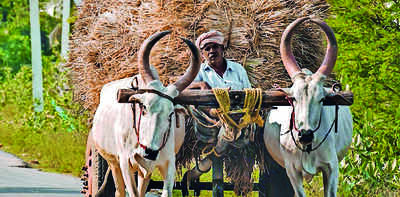Top Searches
- News
- City News
- bhubaneswar News
- Farm mechanisation in Odisha triggers 31% fall in bullock population in 7 years
Farm mechanisation in Odisha triggers 31% fall in bullock population in 7 years
BHUBANESWAR: With increasing use of agricultural machinery especially tractors, demand for bullocks for agricultural purposes has gone down over the years. Official data shows the number of bullocks has decreased by 31 per cent in the last seven years in the state.
Fisheries and animal resources development (FARD) minister Ranendra Pratap Swain told the assembly on Wednesday that requirement of bullocks has declined due to reduction in usage of the animals in ploughing and bullock carts.
Official sources in the FARD department said there were 43 lakh bullocks in 2012, but the total number has drastically fallen to 29.85 lakh in 2019.
The minister said they do not enumerate the population of bulls in the state separately. Odisha Milk Farmers Association (OMFA) chairman Rabi Behera said the situation has drastically changed after the introduction of farm mechanisation techniques and machines. Even rising prices of animal feeds and dearth of cultivable land have contributed to the fall in number of bullocks, he added.
He said people abandon male calves because it does not serve their purpose. People keep the female calves as they can later provide milk, he added.
A Bhubaneswar Municipal Corporation (BMC) official said people abandon the male calves which results in the rise in number of stray bullocks and they pose a threat to commuters. Sometimes even causing accidents.
The official said that they take extra steps to rehabilitate these animals and added that growing population of bullocks is a headache for most urban local bodies.
Fisheries and animal resources development (FARD) minister Ranendra Pratap Swain told the assembly on Wednesday that requirement of bullocks has declined due to reduction in usage of the animals in ploughing and bullock carts.
Official sources in the FARD department said there were 43 lakh bullocks in 2012, but the total number has drastically fallen to 29.85 lakh in 2019.
The minister said they do not enumerate the population of bulls in the state separately. Odisha Milk Farmers Association (OMFA) chairman Rabi Behera said the situation has drastically changed after the introduction of farm mechanisation techniques and machines. Even rising prices of animal feeds and dearth of cultivable land have contributed to the fall in number of bullocks, he added.
He said people abandon male calves because it does not serve their purpose. People keep the female calves as they can later provide milk, he added.
A Bhubaneswar Municipal Corporation (BMC) official said people abandon the male calves which results in the rise in number of stray bullocks and they pose a threat to commuters. Sometimes even causing accidents.
The official said that they take extra steps to rehabilitate these animals and added that growing population of bullocks is a headache for most urban local bodies.

About the Author
Hemanta PradhanHemanta Pradhan writes for the Times of India on education, hospital issues, transport, agriculture & tribal affairs. He has been working as a journalist since 2011. He has a PG degree in Journalism & Mass Communication from Berhampur University. He has won Laadli Media Awards for gender sensitivity.
Start a Conversation
FOLLOW US ON SOCIAL MEDIA
FacebookTwitterInstagramKOO APPYOUTUBE











